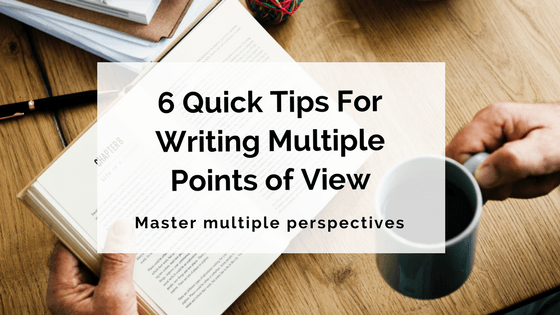One of the first questions you need to answer when beginning a novel is: ‘Whose perspective will I be writing from?’
Depending on your genre, you may choose to take the common route of telling your story from a single perspective – that of your main character. However, there is another option: writing from multiple points of view.

This means telling your story from the perspective of two or more characters, weaving the story together by alternating between viewpoints.
Multi-POV stories are particularly common in speculative fiction, but can be found in any genre.
So no matter what sort of story you’re telling, if you’re thinking of writing multiple points of view, read on for six tips to help you master this storytelling technique.
1. Make sure you have good reason to be writing multiple points of view
First things first, writers: never introduce multiple POVs to your story simply for the sake of it.
Not only is writing multiple points of view a more complicated process, but there are also risks involved.
First and foremost is the risk that in switching constantly between narrators, readers may not feel they really get the chance to know or connect with your characters. You might also confuse or irritate readers if you don’t weave your perspectives together successfully to create a cohesive story.
With these risks and complications in mind, it’s easy to see why there needs to be a good reason for your decision to write a novel using multiple perspectives.
That reason needs to come from the story itself. Ask yourself the question: ‘Why does this story need to be told from multiple points of view?’
The answer could be that there is more than one ‘main’ character whose perspective is vital to the story, or that the scope of the story or world is large, and using only one perspective would be limiting.
Be very sure that you want to commit to writing multiple points of view before beginning your story in this way, especially if you plan to write a series.

2. Ensure each POV character has their own distinct voice
This is perhaps the most important thing to remember when writing multiple points of view. You must develop each POV character’s individual voice so that all the perspectives presented are clearly distinct from one another.
There’s nothing more frustrating than reading a multiple-POV novel in which all the viewpoint characters sound exactly the same. This can contribute to readers feeling bored, confused, or as if they don’t really know your main characters, and even wondering why it was necessary to include certain viewpoints at all.
For this reason, it’s absolutely vital that each POV character’s voice is distinctive enough that all your perspectives don’t blend in with one another.
Now, we’re not saying this is an easy thing to achieve. In fact, it can be extremely difficult to develop and maintain your overall voice as a writer while also developing distinct voices for each POV character. But with some hard work, it can be done!
Everything about a character – from their dialogue and actions, to their internal thoughts and motivations – can be used to develop their unique voice as a POV narrator.
The more thoroughly you know and understand each of your POV characters, the better you’ll be able to develop their voice. So make sure you get to know them inside out!
A note on first and third person
Another decision you need to make when writing multiple points of view is whether to write in first or third person (or a mixture of both). This decision can really help when it comes to developing a distinct voice for each character.
Some writers might find it easier to write each character in first person, as it provides a little more direct insight into a character’s perspective and thoughts.
However, others might find that using first person for all their characters is actually more difficult, and that they’re more easily able to develop voice using close-perspective third person.
It’s totally up to you which you choose – but be sure to choose carefully.

3. Don’t have too many POV characters
As a general rule of thumb, you don’t want to pack your story too full of POV characters, for a number of reasons. Having too many POV characters can:
- Overwhelm or confuse readers
- Make it hard for readers to connect with characters
- Dilute the core story
- Make it hard for you to develop and keep track of so many perspectives, voices and story threads
Now, there are successful books and series – George R. R. Martin’s A Song of Ice and Fire, for example – which use practically too many POV characters to count. However, we don’t recommend taking this approach, particularly if it’s your first time writing multiple points of view.
Sticking to between two and five POV characters is usually a safe bet. This way, you can develop each character fully, tie their storylines together succinctly, and keep readers engaged without confusing them.

4. Stick to a one-chapter-per-POV approach
When you’re writing multiple points of view, you need a way to clearly transition between perspectives. The easiest and most common method is alternating between POV characters chapter by chapter – that is, writing one chapter from one character’s perspective, the next from a different character’s perspective, and so on.
Using the chapter method is vastly preferable to suddenly switching perspectives mid-scene. This is commonly known as ‘head-hopping‘, and is a bad habit to get into!
If you do wish to switch POV characters without a chapter break, there needs to be a clear scene break or marker to distinguish between the two perspectives. But to make things easier on both you and your reader, we recommend sticking to the one-chapter-per POV approach.
An important note: when starting a new POV chapter, you must orient your reader as quickly as possible so they know whose perspective they’ve now switched to.
You can do this by titling each chapter with the POV character’s name, or by making it clear – preferably in the first paragraph – whose head we are now in.

5. Choose carefully which POV you write each scene from
Another of the most important decisions to be made when writing multiple points of view is which parts of the story will be told from whose perspective.
This might be clear in some parts of your story, but less easy to decide in others.
If several of your POV characters are present in the same scene and you can’t decide whose eyes to show it through, asking the following sorts of questions should help you narrow it down:
- Which character has the most at stake in this scene?
- Through which character’s perspective will this scene have the most impact?
- What do I want to convey with this scene, and which character will help me do it best?
Note: you should avoid retelling the same scenes from different perspectives (unless you are using this as a special narrative device in order to reveal important new information or perspectives of the scene).
To avoid slowing the pace of the narrative and boring or frustrating readers, it’s best to deliver each scene through one carefully chosen perspective.

6. Consider choosing one ‘main’ POV character
Our final tip isn’t a set-in-stone guideline – it’s simply an option that might help if you find you’re struggling to streamline and focus your story.
Similarly to novels written with a single perspective, you might like to have one ‘main character’ in your multi-POV novel. This would mean one character receives more ‘screen time’ (i.e. more chapters) than the other POV characters, and whose story and character arc is the overall focus of the novel or series.
Some sprawling multi-perspective epics like A Song of Ice and Fire, which we mentioned above, have dozens of POV characters – some more important than others, but none of whom stand out as the single ‘main’ character.
Other stories have smaller casts of POV characters who are essentially equal in terms of story focus, importance and ‘screen time’ (such as Sabaa Tahir’s An Ember in the Ashes series, with its three main characters).
Many other novels and series utilise multiple points of view while still having one unmistakeable ‘main’ POV character (Sarah J. Maas’ Throne of Glass series or Paula Hawkins’ The Girl on the Train, for example.)
It’s totally up to you which of these approaches you take when writing multiple points of view. However, if you need a clearer direction and focus for your story, consider shaping it with one ‘main’ character in mind, supported by a cast of secondary POV characters.

***
Do you have experience writing multiple points of view? What are your favourite multi-perspective novels or series? Let us know in the comments!
3 responses to “6 Quick Tips For Writing Multiple Points of View”
Great Tips! Have read a lot of books with different points of views and this article explains how to use it well.
Thanks, GrissyG – glad you enjoyed the article!
Thanks for this info. I’m working on a novel with multiple POVs and this article answered many of my questions and concerns about it being ‘too much’, muddling story line, confusing readers etc. Very helpful piece.